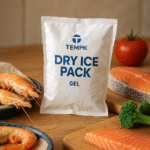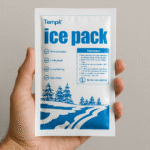What temperature are dry ice packs under real shipping conditions? At standard pressure, dry ice sits at −78.5 °C (−109.3 °F). In a shipper, internal air typically holds between about −70 °C and −20 °C depending on insulation, ventilasi, and pack placement. You’ll see why this range matters, how much dry ice to use, and how to stay compliant in 2025.

-
Exact numbers: what temperature are dry ice packs at the surface, in the box air, and at the product core
-
Sizing made simple: quick math for sublimation rates and a dry ice quantity estimator
-
Safer pack-outs: ventilasi, Label (UN1845), and spacing to prevent freeze damage
-
Smart choices: when dry ice beats gel/PCM—and when it doesn’t
-
Tren untuk 2025: vent membranes, edge-aware loggers, Pemulihan co₂, and digital DG workflows
What temperature are dry ice packs under real shipping conditions?
Jawaban singkat: Dry ice is −78.5 °C at the source; box air stabilizes warmer (≈ −70 °C to −20 °C). Product core lags the air and stays below its spec if you size mass and insulation correctly. This is why what temperature are dry ice packs is a system question, not just a single number.
Mengapa itu penting: If you must hold ≤−18/−20 °C (es krim, Makanan penutup beku, some biologics), a −78.5 °C “cold battery” gives large safety headroom. For 2–8 °C, es kering adalah too cold—use gel or PCM to avoid accidental freezing.
How much dry ice to start with?
A practical daily estimator is:
Es kering (lb) = (Transit hours ÷ 24) × Sublimation rate (lb/24 h)
Plan with typical rates by shipper quality and add a 10–30 % buffer for hand-offs and ambient spikes.
| Shipper Type | Kualitas isolasi | Typical Sublimation (lb/24 h) | Apa artinya bagimu |
|---|---|---|---|
| Busa EPS (≈ 2″ wall) | Bagus sekali | 4–6 | Great for 48–72 h lanes |
| Rigid plastic + liner | Bagus | 6–8 | Balanced cost/hold |
| Corrugated + liner | Sedang | 8–10 | Add mass or shorten route |
| Pallet foam crate | Premi | 10–20 / palet | Scale with openings and cube |
Untuk tipnya: It’s often cheaper to improve insulation than to keep adding dry ice. Better walls reduce loss across every touchpoint.
Pack placement patterns that actually work
-
Top-load only: wastafel dingin; watch bottom warm-up on longer lanes
-
Atas + dasar: flatter gradients for mixed-density loads
-
Surround (sisi + atas): most uniform profile; needs more initial mass
-
Interstitial (between layers): fast pull-down; add spacers for fragile packs
Real-world snapshot: A dessert brand cut temperature excursions by 38 % after switching from top-only blocks to a surround pellet pattern with the same mass.
What temperature are dry ice packs vs. gel and PCM packs?
Intinya: Use dry ice for frozen (≤−20 °C). Use gel/PCM for 2–8 °C or CRT.
| Cooling Element | Set-Point / Behavior | Penggunaan terbaik | Watch-outs |
|---|---|---|---|
| Es kering (CO₂ UN1845) | −78.5 °C sublimes | Deep-frozen lanes | Venting required |
| Paket gel (0 ° C.) | 0 °C melts | Chilled food | Short hold |
| PCM −21 °C | Phase at −21 °C | Makanan beku | Prasyarat |
| PCM +5 ° C. | Phase ≈ +5 ° C. | Vaksin | Avoid freezing |
| PCM +22 ° C. | Phase ≈ +22 ° C. | CRT lanes | Needs insulation |
What temperature are dry ice packs at the product interface—and is it safe?
Contact risk: A −78.5 °C surface can freeze sensitive items on contact. Add a spacer (corrugate, foam tray) and distribute packs evenly.
Compliance checklist
-
Proper name “Carbon dioxide, padat (Es kering), UN1845”
-
Net weight of dry ice on package
-
Ventilasi (tidak pernah kedap udara) container
-
Kelas 9 label bahaya
-
Clear shipper / consignee info
| Topic | Essential Practice | What to Avoid | Mengapa itu penting |
|---|---|---|---|
| Ventilasi | Use vent gaps | Airtight lids | Mencegah penumpukan tekanan |
| Pelabelan | UN1845 + berat + Kelas 9 | Missing weights | Penerimaan lebih cepat |
| Penanganan | Sarung tangan terisolasi | Bare-hand contact | Avoids frost injury |
Tips Praktis
-
Door cycles: minimize openings
-
Logger location: near payload core
-
Lane design: prefer predictable curves, not perfect symmetry
How much dry ice do you need for 24–96 h lanes?
Contoh: 48 h lane, EPS shipper, ≈ 5 lb / 24 h →
(48 / 24) × 5 = 10 lb + 10–20 % buffer → 11–12 lb total.
Validation beats theory—tune to your kit and lanes.
2025 trends in dry ice temperature control
Fresh in 2025: Smarter vent membranes, edge-aware loggers, CO₂ merebut kembali, and digital DG workflows cut cost and emissions.
Highlight
-
Microporous vent lids stabilize internal air
-
Edge-aware loggers catch corner leaks early
-
Lower-carbon dry ice from CO₂ capture
-
Digital declarations reduce errors
Wawasan pasar: Frozen DTC and biologics growth favors lighter, surround pack-outs with better insulation for cost control.
FAQ
Q1: What temperature are dry ice packs at the start of a trip?
About −78.5 °C at surface/core; internal air warms to −70 °C to −20 °C depending on design.
Q2: Can I use dry ice for 2–8 °C?
TIDAK. It’s too cold—use +5 °C PCM or gel packs.
Q3: Pellets or slabs?
Pellets distribute evenly; lempengan bertahan lebih lama. Hybrid works best.
Q4: How close can dry ice be to my product?
Hindari kontak langsung; use a spacer and rely on box air temp.
Q5: Berapa lama es kering bertahan?
Typically 18–96 h depending on insulation, massa, and ambient.
Ringkasan & Rekomendasi
Poin -poin penting: What temperature are dry ice packs = −78.5 °C source; box air warmer.
Use dry ice for frozen lanes, PCM/gel for 2–8 °C. Always vent, label, and log.
Langkah selanjutnya:
-
Tentukan suhu target & lane time.
-
Choose correct coolant.
-
Perkirakan massa + 10–30 % penyangga.
-
Use Top+Bottom or Surround layout.
-
Validate with loggers.
CTA: Ready to validate a −20 °C or −70 °C lane? Book a 10-minute pack-out review with Tempk.
Tentang tempk
We design validated frozen, didinginkan, and CRT pack-outs with proven insulation and accessories that hit −20 °C and −70 °C profiles reliably. Every design is backed by pilot data and SOPs that teams can follow easily.























